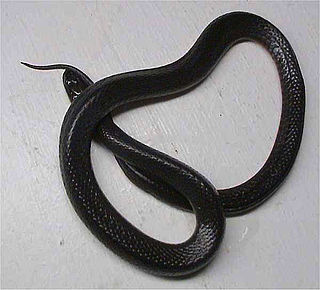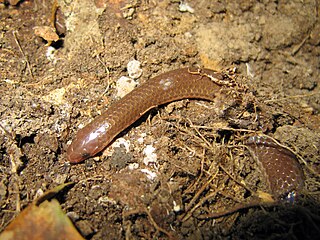
Robert Kennicott was an American naturalist and herpetologist. Chronic illness kept Kennicott out of school as a child. Instead, Kennicott spent most of his time outdoors, collecting plants and animals. His father schooled him at home and convinced naturalist Jared Potter Kirtland to take him as an understudy. Soon, Kennicott was providing specimens for the Smithsonian Institution via assistant secretary Spencer Fullerton Baird.

Pituophis is a genus of nonvenomous colubrid snakes, commonly referred to as gopher snakes, pine snakes, and bullsnakes, which are endemic to North America.

The timber rattlesnake, canebrake rattlesnake, or banded rattlesnake is a species of pit viper endemic to eastern North America. Like all other pit vipers, it is venomous, with a very toxic bite. C. horridus is the only rattlesnake species in most of the populous Northeastern United States and is second only to its relatives to the west, the prairie rattlesnake, as the most northerly distributed venomous snake in North America. No subspecies are currently recognized.

The black swamp snake is a species of snake in the subfamily Natricinae of the family Colubridae. The species is endemic to the southeastern United States. There are three subspecies, including the nominotypical subspecies.

Heterodon is a genus of harmless colubrid snakes endemic to North America. They are stout with upturned snouts and are perhaps best known for their characteristic threat displays. Three species are currently recognized. Members of the genus are commonly known as hognose snakes, hog-nosed snakes, North American hog-nosed snakes, and colloquially puff adders.

Nerodia is a genus of nonvenomous colubrid snakes commonly referred to as water snakes due to their aquatic behavior. The genus includes nine species, all native to North America. Five of the species have recognized subspecies.

Carphophis is a genus of small colubrid snakes endemic to the United States. The genus consists of two species, one of which has two subspecies.

Carphophis vermis is a species of small, nonvenomous colubrid snake native to the United States.

Thamnophis saurita, also known as the eastern ribbon snake, common ribbon snake, or simply ribbon snake, is a common species of garter snake native to Eastern North America. It is a non-venomous species of snake in the subfamily Natricinae of the family Colubridae. The ribbon snake averages 16 to 35 inches in total length. It is dark brown with bright yellow stripes. The ribbon snake is not sexually dimorphic; however, females are normally thicker than their male counterparts.

Ficimia streckeri, also commonly known as the Mexican hooknose snake, the Tamaulipan hooknose snake, and the Texas hook-nosed snake, is a small species of snake in the family Colubridae. The species is native to northeastern Mexico and adjacent southern Texas.

The smooth earth snake is a species of nonvenomous natricine colubrid snake native to the eastern half of the United States.

Haldea striatula, commonly called the rough earth snake, is a species of nonvenomous natricine colubrid snake native to the Southeastern United States.

Pituophis melanoleucus, commonly known as the eastern pine snake, is a species of nonvenomous snake in the family Colubridae. The species is endemic to the southeastern United States. Three subspecies are currently recognized as being valid.

The crayfish snake, also known commonly as the glossy crayfish snake, the glossy swampsnake, the glossy water snake, and the striped water snake, is a species of semiaquatic snake in the subfamily Natricinae of the family Colubridae. The species is endemic to the southeastern United States, and preys mainly on crayfish.

Kirtland's snake is a threatened or endangered North American species of nonvenomous snake of the subfamily Natricinae, of the family Colubridae. It is the only species in the genus Clonophis.

Lampropeltis getula, commonly known as the eastern kingsnake, common kingsnake, or chain kingsnake, is a harmless colubrid species endemic to the United States and Mexico. It has long been a favorite among collectors. Nine subspecies are currently recognized, including the nominate subspecies described here.

The northern redbelly snake is a nonvenomous snake in the family Colubridae, a subspecies of Storeria occipitomaculata. It is native to North America.

The southern ribbon snake(Thamnophis saurita sackenii), also known commonly as the peninsula ribbon snake and the Florida ribbon snake, is a subspecies of garter snake in the family Colubridae. It is one of four subspecies of the ribbon snake.

The eastern worm snake is a subspecies of the worm snake, Carphophis amoenus, a nonvenomous colubrid endemic to the Eastern Woodlands region of North America. The species' range extends from southwest Massachusetts, south to southern Alabama, west to Louisiana and north to Illinois. This species is common in the ecotone between woodlands and wetlands. It may also be found in grasslands adjacent to woodlands. Though this snake can be abundant in parts of its range, it is rarely seen because of its fossorial lifestyle. When not underground, C. a. amoenus resides mostly under rocks, logs and leaf litter, or burrowed within rotting woody debris. This snake is perfectly safe to pick up, as it cannot bite, but may produce a foul-smelling excretion.

Carphophis amoenus, commonly known as the worm snake, is a species of nonvenomous colubrid snake endemic to the eastern United States. C. amoenus can be found east of the Mississippi, from southwest Massachusetts south to southern Alabama west to Louisiana and then north to Illinois. This species of snake protects a large range, and normally prefers a moist habitat in the rocky woodlands, under rotten wood of logs and stumps. Though this snake is quite abundant over its range, it is rarely seen because of its dormant lifestyle and where it usually resides. This snake is most common on the edges or in the ecotonal areas of open to thick woodlands, and the borders of wetlands. It may also be found in the grasslands next to woodlands. The best chance to spot it is after heavy rains, when its small size and distinct color make it easy to spot. This species prefers moist soil inhabited by earthworms, which are its main prey, so the soil needs to be sufficiently moist. The snake's skin naturally evaporates water; so the soil needs to be moist enough to offset this. C. amoenus is mostly found under rocks and in sufficient leaf litter during the extreme daytime heat. Peak activity falls between 15:00 to 18:00.



















